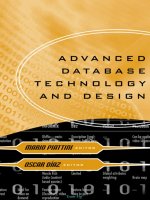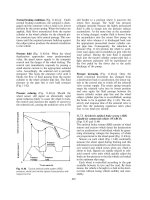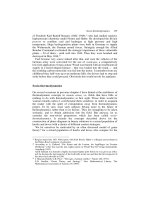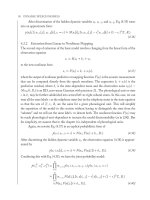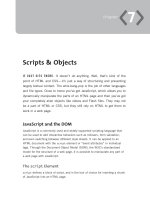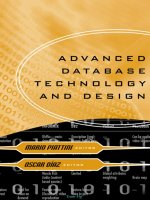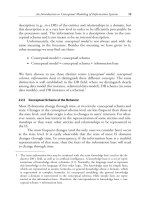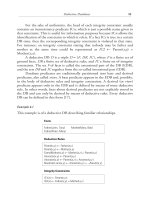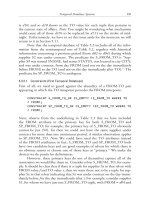Advanced Database Technology and Design phần 6 ppt
Bạn đang xem bản rút gọn của tài liệu. Xem và tải ngay bản đầy đủ của tài liệu tại đây (481.61 KB, 56 trang )
We also have to illustrate the events arising from the temporal state
changes of an actor, that is, when object A starts its presentation, then the
A> temporal event is raised. Special attention should be paid to the event
generated when the actor finishes its execution naturally when there are no
more data to be presented (<) and to distinguish this event from the TAC
operator !. Therefore,
t_event :==>|<||>||||>>|<<
We define now temporal composition representation. Let A, B be two actors.
Then the expression A t_event t_interval TAC_operator B represents all the
temporal relationships between the two actors, where t_interval corresponds
to the length of a vacant temporal interval. Therefore,
temporal_composition :==(Θ | object [{temp_rel object}])
temp_rel:==t_event t_interval TAC_operator
For instance, the expression: Θ >0> A >4! B <0> C conveys this message:
zero seconds after the start of the application, start A; 4 seconds after the
start of A, stop B; 0 seconds after the end of B, start C.
Finally, we define the duration d
A
of a multimedia object A as the tem-
poral interval between the temporal events A> and A<. Another aspect of
object composition in IMDs is related to the spatial layout of the application,
that is, the spatial arrangement and relationships of the participating objects.
The spatial composition aims at representing three aspects:
•
The topological relationships between the objects (disjoint, meet,
overlap, etc.);
•
The directional relationships between the objects (left, right, above,
above-left, etc.);
•
The distance characteristics between the objects (outside 5 cm, inside
2 cm, etc.).
Spatiotemporal Composition Model
An IMD scenario presents media objects composed in spatial and temporal
domains. A model that captures those requirements is presented here. For
uniformity reasons, we exploit the spatiotemporal origin of the image,
Θ,
that corresponds to the spatial and temporal start of the application (i.e.,
Multimedia Database Management Systems 263
TEAMFLY
Team-Fly
®
upper left corner of the application window and the temporal start of the
application). Another assumption we make is that the objects that participate
in the composition include their spatiotemporal presentation characteristics
(i.e., size, temporal duration). We define the spatiotemporal model as
follows:
Assuming two spatial objects A, B, we define the generalized spatial
relationship between those objects as sp_rel = (r
ij
, v
i
, v
j
, x, y), where r
ij
is the
identifier of the topological-directional relationship between A and B; v
i
, v
j
are the closest vertices of A and B, respectively (as defined in [9]); and x, y are
the horizontal and vertical distances between v
i
, v
j
.
We define now a generalized operator expression to cover the spatial
and temporal relationships between objects in the context of a multimedia
application. It is important to stress that, in some cases, we do not need to
model a relationship between two objects, but to represent the spatial and/or
temporal position of an object relative to the application spatiotemporal ori-
gin,
Θ (i.e., object A to appear at the spatial coordinates (110, 200) on the
tenth second of the application).
We define a composite spatiotemporal operator that represents
absolute spatial/temporal coordinates or spatiotemporal relationships
between objects in the application as ST_R(sp_rel, temp_rel ), where sp_rel
is the spatial relationship and temp_rel is the temporal relationship as already
defined.
The spatiotemporal composition of a multimedia application consists
of several independent fundamental compositions. In other words, a scenario
consists of a set of acts that are independent of each other. The term inde-
pendent implies that actors participating in them are not related explicitly
(either spatially or temporally), though there is always an implicit relation-
ship through the origin
Θ. Thus, all compositions are explicitly related to Θ.
We call these compositions, which include spatially and/or temporally
related objects, composition_tuples.
We define the composition_tuple in the context of a multimedia appli-
cation as composition_tuple :==Ai [{ ST_R Aj}], where Ai, Aj are objects par-
ticipating in the application, and ST_R is a spatiotemporal relationship (as
defined above).
We define the composition of multimedia objects in the context of
multimedia applications as a set of composition_tuples: composition =
Ci{,Cj}, where Ci, Cj are composition_tuples.
The EBNF definition of the spatiotemporal composition based on the
above is as follows:
264 Advanced Database Technology and Design
composition :==composition_tuple{[,composition_tuple]}
composition_tuple :==
(Θ| object) [{spatio_temporal_relationship object}]
spatio_temporal_relationship :== [([sp_rel),(temp_rel)]
sp_rel :==( rij , vi , vj , x , y )
x:==INTEGER
y:==INTEGER
temp_rel
1
:==t_event t_interval TAC_operator
where r
ij
denotes a topological-directional relationship between two objects
and vi, vj denotes the closest vertices of the two objects. The term action was
defined previously.
8.3.1.3 The Scenario Model
The term scenario in the context of IMDs stands for the integrated behavioral
contents of the IMD, that is, what kind of events the IMD will consume
and what actions will be triggered as a result. The scenario, in the current
approach, consists of a set of autonomous functional units (scenario tuples)
that include the triggering events (for starting and stopping the scenario
tuple), the presentation actions to be carried out in the context for the sce-
nario tuple, related synchronization events, and possible constraints. More
specifically, a scenario tuple has the following attributes:
•
Start_event represents the event expression that triggers the execu-
tion of the actions described in Action_List.
•
Stop_event represents the event expression that terminates the execu-
tion of this tuple (i.e., the execution of the actions described in
Action_List before its expected termination).
•
Action_List represents the list of synchronized media presentation
actions that will take place when this scenario tuple becomes acti-
vated. The expressions included in this attribute are in terms of
compositions as described in previous sections and in [9].
Multimedia Database Management Systems 265
1. Specifically in the current implementation, we adopted the ∧ operator. Then the com-
position A∧B that corresponds to the expression (A>0>B);(A<0!B);(B<0!A) can be ex-
pressed in natural language: Start A and B simultaneously and when the temporally
shorter ends, the other object is stopped as well.
•
Synch_events refers to the events (if any) generated at the beginning
and the end of the current tuple execution. These events can be used
for synchronization purposes.
The scenario tuple is defined as follows:
scenario:==scenario_tuple [{,scenario_tuple}]
scenario_tuple :==Start_event , Stop_event , Action_List ,
Synch_events
Start_event :==Event
Stop_event :==Event
Action_List :==composition
Synch_events :==( start, end )
start :==Event|
stop :==Event|
Section 8.2 presented a sample IMD scenario with rich interaction and com-
position features. One of the parts of the scenario adheres to the following
verbal description.
The next set of media presentations (Stage 2B) is initiated when the
sequence of events _IntroStop and _ACDSoundStop occurs. During
Stage2B the video clip KAVALAR starts playback while the buttons
NEXTBTN and EXITBTN are presented. The presentation actions are
interrupted when any of the events _TIMEINST and _NextBtnClick
occurs. The end of Stage2B raises the synchronization event _e1.
The IMD scenario model can represent that functionality by the following
scenario tuple definition:
TUPLE Stage2B
Start Event = SEQ(_IntroStop;_ACDSoundStop)
Stop Event = ANYNEW(1;_TIMEINST;_NextBtnClick)
Action List = KAVALAR 0 NEXTBTN 0 EXITBTN
Synch Events = (_, e1)
8.3.2 IMD Retrieval Issues
As regards retrieval issues, we will mainly discuss the issues related to retrieval
and presentation of IMDs, which are broader than those of monomedia
objects.
266 Advanced Database Technology and Design
•
Synchronization and presentation: The retrieval and presentation of
multimedia objects from an MM-DBMS bear some specific features
arising from the time-dependent features of most media types. For
instance, for a video clip to be presented properly, we need to ensure
adequate data throughput (i.e., 25 frames per second) so that the
presentation is continuous and of acceptable quality. This is a multi-
parameter issue involving several technological factors, such as com-
munication networks, secondary storage technology, compression
algorithms, and so on. Then, given that this issue (known as the
intramedia synchronization problem) is tackled, we have to take into
account the different synchronization relations among sets of
objects. The well-known example of a talking head requires that
the audio clip be in synchrony with the video clip so that lip syn-
chronization is achieved.
•
Query languages, content-based retrieval, and indexing: Another
important issue related to retrieval is content-based retrieval, which
has attracted important research efforts and industrial interest.
Research has focused on content-based image indexing, that is, fast
retrieval of objects using their content characteristics (color, texture,
shape). For example, in [10] a system, called QBIC, that couples sev-
eral features from machine vision with fast indexing methods from
the DB area is proposed to support color-, shape-, and texture-
matching queries. Nearest-neighbor queries (based on image con-
tent) are addressed in [11]. In general, indexing of objects contents
is an active research area, while indexing of objects extends in the
spatiotemporal coordinate system sets a new direction. This chapter
presents the research efforts we have completed in the area of index-
ing and retrieval of IMDs based on their spatiotemporal struc-
tures [6].
8.3.2.1 Retrieval of IMDs Based on the Spatiotemporal Structure
As mentioned previously, the retrieval of multimedia documents on the
basis of their spatiotemporal structure is a challenging theme. This chapter
presents the research effort we have completed in the area of indexing and
retrieval of IMDs based on their spatiotemporal structures [6]. During the
IMD development process, it can be expected (especially in the case of com-
plex and large applications) that the authors would need information related
to the spatiotemporal features of an IMD. The related queries, depending on
Multimedia Database Management Systems 267
the spatiotemporal relationships that are involved, can be classified in the fol-
lowing categories:
•
Pure spatial or temporal. Only a temporal or a spatial relationship is
involved. For instance, Which objects temporally overlap the pres-
entation of logo D? Which objects spatially lie above object D in
the application window?
•
Spatiotemporal. Where such a relationship is involved. For instance,
Which objects spatially overlap with object D during its presenta-
tion?
•
Layout, related to the spatial or temporal layout of the application. For
instance, What is the screen layout on the 22nd second of the
application? Which objects are presented between the 10th and
20th seconds of the application? (temporal layout).
A simple serial storage scheme that includes objects spatial and temporal
coordinates is an inefficient solution because typical IMDs include thou-
sands of objects. Hence, indexing techniques that could be able to efficiently
handle spatial and temporal characteristics of objects need to be adopted. We
propose such efficient indexing mechanisms to support queries, like the ones
listed above, in a large IMD.
Indexing Techniques for Large IMDs
As discussed in preceding sections, IMDs usually involve a large amount of
media objects, such as images, video, sound, and text. The quick retrieval of a
qualifying set, among the huge amount of data, that satisfies a query based on
spatiotemporal relationships is necessary for the efficient construction of an
IMD. Spatial and temporal features of objects are identified by six coordi-
nates: the projections on the x-axis (points x
1
, x
2
), y-axis (points y
1
, y
2
), and
t-axis (points t
1
, t
2
).
2
A serial storage scheme, maintaining the object charac-
teristics as a set of seven values (id, x
1
, x
2
, y
1
, y
2
, t
1
, t
2
) and organizing them
into disk pages, is not an efficient solution. Lack of ordering leads to the
access of all pages for answering any query, like the above example queries.
However, this scheme is used as the baseline for the evaluation of our pro-
posals later in this chapter. A more efficient but still simplified solution (as
268 Advanced Database Technology and Design
2. We adopt a unified three-dimensional workspace for space (two dimensions) and time
(one dimension) features.
presented next) is based on the maintenance of three disk arrays that keep
low coordinates of objects (i.e., x
1
, y
1
, and t
1
) separate in a sorted order.
3
Several queries involving spatiotemporal operators require the retrieval
of one array only, using divide-and-conquer techniques. Temporal layout
queries belong to this group. However, the majority of queries involves infor-
mation about more than one axis. Thus, the retrieval of more than one array
and the subsequent combination of the answer sets are necessary for such
cases. Efficient indexing mechanisms that could combine spatiotemporal
characteristics of objects to efficiently support a wide range of spatiotemporal
operators need to be present in an IMD authoring tool. The next subsections
propose two indexing schemes and their retrieval procedures.
A Simple Spatial and Temporal Indexing Scheme
A simple indexing scheme that could handle spatial and temporal character-
istics of media objects consists of two indexes:
• A spatial (two-dimensional) index for spatial characteristics (the id
and the x
1
, x
2
, y
1
, y
2
values) of the objects;
• A temporal index for temporal characteristics (the id and the t
1
, t
2
val-
ues) of the objects.
As an example, Figure 8.1 shows such an index based on the well-known
multidimensional indexing scheme of R-trees [12].
We argue that the adoption of this indexing scheme improves the
retrieval of spatiotemporal operators compared to the sorted-arrays scheme.
Even for complex operators where both tree indexes need to be accessed (e.g.,
for the overlap_during operator), the cost of the two indexes response times
is expected to be lower than the retrieval cost of the (three) arrays. A weak
point of the scheme already has been mentioned. The retrieval of objects
according to their spatiotemporal relationships (e.g., the overlap_during one)
with others demands access to both indexes and, in a second phase, the com-
putation of the intersection set between the two answer sets. Access to both
indexes is usually costly, and, in many cases, most of the elements of the two
answer sets are not found in the intersection set. In other words, most of the
disk accesses to each index separately are useless. A more efficient solution is
Multimedia Database Management Systems 269
3. Instead of using low coordinates, one can select high coordinates (or six arrays with low
and high coordinates). The decision does not affect the discussion that follows and its
conclusions.
the merging of the two indexes (the spatial and the temporal one) in a unified
mechanism. This scheme is proposed next.
A Unified Spatiotemporal Indexing Scheme
We propose a unified spatiotemporal indexing scheme that eliminates the
inefficiencies of the previous scheme and further improves the performance
of an IMD tool. The proposed indexing scheme consists of only one index: a
spatial (three-dimensional) index for the complete spatiotemporal information
(location in space and time coordinates) of the objects. If we assume that the
R-tree is an efficient spatial indexing mechanism, then the unified scheme is
illustrated in Figure 8.2. The main advantages of the proposed scheme, when
compared to the previous one, are the following.
•
The indexing mechanism is based on a unified framework. Only one
spatial data structure (e.g., the R-tree) needs to be implemented and
maintained.
•
Spatiotemporal operators are more efficiently supported. Using the
appropriate definitions, spatiotemporal operators are implemented
as three-dimensional queries and retrieved using the three-
dimensional index, so the need for (time-consuming) spatial joins is
eliminated.
270 Advanced Database Technology and Design
Multimedia DB
Spatial info Temporal info
2D R-tree 1D R-tree
Figure 8.1 A simple (spatial and temporal) indexing scheme.
Retrieval of Spatiotemporal Operators Using R-Trees
The majority of multidimensional data structures has been designed as exten-
sions of the classic alphanumeric index, B-tree. They usually divide the plane
into appropriate subregions and store those subregions in hierarchical tree
structures. Objects are represented in the tree structure by an approximation
(the minimum bounding rectangle (MBR) approximation being the most
common one) instead of their actual scheme, for simplicity and efficiency
reasons. Unfortunately, the relative position of two MBRs does not convey
the full information about the spatial (topological, direction, distance) rela-
tionship between the actual objects. For that reason, spatial queries involve
the following two-step strategy [13]:
•
Filter step: The tree structure is used to rapidly eliminate objects that
could not possibly satisfy the query. The result of this step is a set of
candidates that includes all the results and possibly some false hits.
•
Refinement step: Each candidate is examined (by use of computa-
tional geometry techniques). False hits are detected and eliminated.
R-tree [12] is one of the most efficient hierarchical multidimensional data
structures. A height-balanced tree, it consists of intermediate and leaf nodes
Multimedia Database Management Systems 271
Multimedia DB
Spatiotemporal info
3D R-tree
Figure 8.2 A unified (spatiotemporal) indexing scheme.
(stored in secondary memory as disk pages). The MBRs of the actual data
objects are assumed to be stored in the leaf nodes of the tree. Intermediate
nodes are built by grouping rectangles (or hyperrectangles, in general) at
the lower level. An intermediate node is associated with some rectangle that
encloses all rectangles that correspond to lower level nodes. To retrieve
objects that belong to the answer set of a spatiotemporal operator, with respect
to a reference object, we have to specify the MBRs that could enclose such
objects and then search the intermediate nodes that contain those MBRs. This
technique was proposed and implemented in [14] to support spatial operators
of high resolution (e.g., meet, contains) that are popular in GIS applications.
As an example, Figure 8.3(b) shows how the MBRs corresponding
to the presentations of the objects are grouped and stored in the three-
dimensional R-tree of our unified scheme. We assume a branching factor of
4, that is, each node contains, at most, four entries. At the lower level, MBRs
of objects are grouped into two nodes, R1 and R2, which in turn compose
the root of the index. We consider a spatiotemporal query, that is, the over-
lap_during operator, with D being the reference object q.Toanswerthis
query, only R2 is selected for propagation. Among the entries of R2, objects C
and (obviously) D are the ones that constitute the qualified answer set. Note
that only the right subtree of the R-tree index in Figure 8.3(a) was propagated
272 Advanced Database Technology and Design
(a)
x
y
t
A
B
C
D
F
E
R1
R2
(b)
AE B
R1
F
R2
CD
Figure 8.3 Retrieval of overlap_during operator using 3D R-trees.
to answer the query. The rate of the accessed nodes heavily depends on the
size of the reference object q and, of course, the kind of the operator (more
selective operators result in a smaller number of accessed nodes).
Let us now consider a spatial query, that is, the overlap operator with D
being the reference object q. Because the query gives no temporal informa-
tion on the reference object, the unified scheme transforms it to a large cube
that covers the whole t-axis. In this case, the simple scheme, presented before,
could be more efficient, since the two-dimensional R-tree that is dedicated
to spatial information of objects is able to answer the query. Similarly, a tem-
poral query (i.e., the during operator) could also be efficiently supported by
the simple scheme.
A special type of query, which is popular in IMD authoring, consists of
spatial or temporal layout retrieval. In other words, queries of the type Find
the objects and their position in screen at the T
0
second (spatial layout) or
Find the objects that appear in the application during the (T
1
,T
2
) temporal
segment and their temporal duration (temporal layout) need to be sup-
ported by the underlying scheme. As we will present next, both types of que-
ries are efficiently supported by the unified scheme, since they correspond to
the overlap_during operator and an appropriate reference object q: a rectan-
gle q
1
that intersects the t-axis at point T
0
, or a cube q
2
that overlaps the t-axis
at the (T
1
,T
2
) segment, respectively. The reference objects q
1
and q
2
are illus-
trated in Figure 8.4(a). In a second step, the objects that make up the answer
set are filtered in main memory to design their positions on the screen (spa-
tial layout) or the intersection of their t-projections to the given temporal
segment (temporal layout).
In particular, spatial layout could be answered by exploiting the refer-
ence object q
1
at the specific time instance T
0
= 22 seconds. The result would
be a list of objects (the identifiers of the objects and their spatial and tempo-
ral coordinates) that are displayed at that temporal instance on the screen.
This result can be visualized as a screen snapshot with the objects that are
included in the answer set drawn in, as shown in Figure 8.4(b). As for tem-
poral layout query with constraints, it could be answered using as a refer-
ence object a cube q
2
having dimensions (X
max
− 0) ⋅ (Y
max
− 0) ⋅ (T
2
− T
1
)
where X
max
⋅ Y
max
is the dimension of the screen and (T
2
− T
1
) is the requested
temporal interval; T
1
= 10 and T
2
= 20 in our example. The result would be a
list of objects (the identifiers of the objects and their spatial and temporal
coordinates) that are included or overlapped with cube q
2
. This result can be
visualized toward a temporal layout by drawing the temporal line segments
of the retrieved objects that lie within the requested temporal interval
(T
2
− T
1
), as shown in Figure 8.4(c).
Multimedia Database Management Systems 273
TEAMFLY
Team-Fly
®
On the other hand, the simple indexing scheme (consisting of two
index structures) is not able to give straightforward answers to the above lay-
out queries, because information stored in both indexes needs to be retrieved
and combined.
8.4 Conclusions
8.4.1 Main Achievements of MM-DBMS Technology
So far, the MM-DBMS industry and research have invested significant
efforts to the design and development of DB support for the special features
of media objects and documents. The capabilities of the current MM-DBMS
approaches in the research and industrial domains are summarized in [15].
A MM-DBMS may contain either single-media objects (i.e., images, video
clips) or IMDs. Previous sections of this chapter elaborated on modeling and
retrieval of IMDs; this section focuses on single-media DBs.
8.4.1.1 Modeling
There has been a substantial amount of work in recent years on multimedia.
Zdonik [16] has specified various roles that DBs can play in complex
274 Advanced Database Technology and Design
x
y
t
A
B
C
D
F
E
R1
R2
T1*
T2*
q1
q2
T0*
(a)
C
D
A
Q
(b)
Time
F
E
A
10 13 17 20È
C
B
(c)
Figure 8.4 Spatial and temporal layout retrieval using 3D R-trees: (a) query windows for
spatial and temporal layout; (b) spatial layout; (c) temporal layout.
multimedia systems. One role is the logical integration of data stored on
multiple media. Kim et al. [17, 18] show how object-oriented DBs (with
some enhancements) can be used to support multimedia applications. Their
model is a natural extension of the object-oriented notions of instantiation
and generalization. The general idea is that a multimedia DB is considered to
be a set of objects that are interrelated to each other in various ways.
Little and Ghafoor [7] have developed methods for satisfying temporal
constraints in multimedia systems. In a similar vein, Prabhakaran and
Raghavan [19] show how multimedia presentations can be synchronized.
Other related works are the following: Gaines and Shaw [2] have devel-
oped an architecture to integrate multiple document representations. Eun et
al. [20] show how Milners calculus of communicating systems can be used
to specify interactive multimedia, but they do not address the problem of
querying the integration of multiple media.
8.4.1.2 Integrity
There have been research efforts on the issue of multimedia document verifi-
cation and integrity. In [21], a synchronization model for the formal descrip-
tion of multimedia documents is presented, while [22] explores an approach
for automatic generation of consistent presentation schedules. In [21], the
user formalization is automatically translated into an RT-LOTOS formal
specification, allowing verification of a multimedia document aiming to
identify potential temporal inconsistencies. Multimedia documents are
described through a hierarchical model, and incomplete timing is allowed. In
[22], a temporal constraint satisfaction algorithm is presented. The algo-
rithm generates consistent schedules, according to acceptable durations that
the author defines. The system covers both preorchestrated specifications
and interactive ones. The algorithm has two phases, and a compile time
scheduler can smooth predictable temporal inconsistencies to produce dura-
tion of desired or necessary duration, contrary to our approach, in which
durations are not smoothed.
In [23] an approach is presented that addresses the key issue of provid-
ing flexible multimedia presentation with user participation and suggests
synchronization models that can specify the user participation during the
presentation. A dynamic timed Petri net structure is proposed that can
model preemptions and modifications to the temporal characteristics of the
net. This structure can be adopted by the object composition petri nets
(OCPN) to facilitate modeling of multimedia synchronization characteristics
with dynamic user participation. In [24] a framework for checking the tem-
poral consistency of a composition of media objects is provided. The
Multimedia Database Management Systems 275
temporal composition is defined in terms of directed acyclic graphs, in which
the nodes are objects and the edges represent temporal relations. The con-
cepts of qualitative and quantitative inconsistency are introduced. The first
concept is related to the incompatibility of a set of temporal relations, and
the second concept is related to the relations that arise from the errors that
occur due to the specific durations of media objects.
8.4.1.3 Content-Based Retrieval
The retrieval of multimedia information from DBs is evolving as a challeng-
ing research and industrial area. There is already a substantial volume of
results in both levels. This section reviews important efforts in this topic, spe-
cifically research for image and video retrieval based on content.
Image Retrieval
Image retrieval is concerned with retrieving images relevant to users queries
from a large image collection. The relevance is determined by the nature of
the application. For instance, in a fabric-image DB, relevant images would be
those matching a sample in terms of texture and color. In a news photogra-
phy DB, date, time, and the occasion at which the photograph was taken
may be just as important as the actual visual content. Many relational DB
systems support fields for binary large objects (BLOBs) and facilitate access
by user-defined attributes such as date, time, media type, image resolution,
and source. On the other hand, content-based systems analyze the visual
content of images and index extracted features.
Possible query categories involving one or more features are proposed
in [25].
•
Simple visual feature query. The user specifies certain values possibly
with percentages for a feature. Example: Retrieve images which
contain 70 percent blue, 20 percent red, 30 percent yellow.
•
Feature combination query. The user combines different features and
specifies their values and weights. Example: Retrieve images with
green color and tree texture where color has weight 75 percent and
texture has weight 25 percent.
•
Localized feature query. The user specifies feature values and loca-
tions by placing regions on a canvas. Example: Retrieve images
with sky blue at the upper half and green at the bottom half.
•
Query by example. The system generates a random set of images. The
user selects one image and retrieves similar images. Similarity can be
276 Advanced Database Technology and Design
determined based on user-selected features. Example: Retrieve
images that contain textures similar to this example. A slightly dif-
ferent version of this type of query is one in which the user cuts a
region from an example image and pastes it onto the query canvas.
•
Object versus image. The user can describe the features of an object in
an image as opposed to describing a complete image. Example:
Retrieve images containing a red car near the center.
•
User-defined attribute query. The user specifies the values of the
user-defined attributes. Example: Retrieve images in which location
is Washington, D.C., and the date is July 4, and the resolution is at
least 300 dots per inch.
•
Object relationship query. The user specifies objects, their attributes,
and the relationships among them. Example: Retrieve images in
which an old man is holding a child in his arms.
•
Concept queries. Some systems allow the user to define simple con-
cepts based on the features extracted by the system. For instance, the
user may define the concept of a beach as Small yellow circle at top,
large blue region in the middle, and sand color in the lower half.
Combination queries can involve any number of those query primitives as
long as the retrieval system supports such queries. The visual content of an
image is summarized as follows. Visual content can be modeled as a hierar-
chy of abstractions. At the first level are the raw pixels with color or bright-
ness information. Further processing yields features such as edges, corners,
lines, curves, and color regions. A higher abstraction layer may combine and
interpret those features as objects and their attributes. At the highest level are
the human-level concepts involving one or more objects and relationships
among them. An example concept might be a person giving a speech.
Although automatic detection and recognition methods are available for cer-
tain objects and their attributes, their effectiveness is highly dependent on
image complexity. Most objects, attribute values, and high-level concepts
cannot be extracted accurately by automatic methods. In such cases, semiau-
tomatic methods or user-supplied keywords and annotations are employed.
Next, we describe the various levels of visual features and the techniques for
handling them.
Some of the visual features of images are briefly presented next. Color
plays a significant role in image retrieval. Different color representation
schemes include red-green-blue (RGB), the chromaticity and luminance
Multimedia Database Management Systems 277
system of the International Commission on Illumination (CIE), hue-
saturation-intensity (HSI), among others. The RGB scheme is most com-
monly used in display devices. Texture is a visual pattern in which a large
number of visible elements are densely and evenly arranged. A texture ele-
ment is a uniform-intensity region of simple shape that is repeated. Shape-
based image retrieval is a hard problem in general image retrieval because of
the difficulty of segmenting objects of interest in the images. Consequently,
shape retrieval typically is limited to well-distinguished objects in the image.
For indexing visual features, a common approach is to obtain numeric
values for n features and then representing the image or object as a point in
the n-dimensional space. Multidimensional access methods, such as K-D-B-
trees, quad-trees [26, 27], R-trees [28], or their variants (R∗-trees, hB-trees,
X-trees, TV-trees, SS-trees, SR-trees, etc.), are then used to index and
retrieve relevant images. Problems arise in indexing in this context [25].
First, most multidimensional methods work on the assumption that different
dimensions are independent; hence, the Euclidean distance is applicable.
Second, unless specifically encoded, feature layout information is lost. In
other words, the locations of the features can no longer be recovered from the
index. The third problem is the number of dimensions. The index structures
become very inefficient as the number of dimensions grows. To solve those
problems, several approaches have been developed. We first look at the
color-indexing problem. Texture and shape retrieval share some of these
problems, and similar solutions are applicable.
An important constituent of the image content is the information on
objects identified in the image. Object detection involves verifying the pres-
ence of an object in an image and possibly locating it precisely for recogni-
tion. In both feature-based and template-based recognition, standardization
of global image features and registration (alignment) of reference points are
important. The images may need to be transformed to another space for
handling changes in illumination, size, and orientation. Both global and
local features play important roles in object recognition. In local feature-
based object recognition, one or more local features are extracted and the
objects of interest are modeled in terms of those features. For instance, a
human face can be modeled by the size of the eyes, the distance between the
eye and the nose, and so on. Recognition then can be transformed into a
graph-matching problem.
Cardenas et al. [29] have developed a query language called
PICQUERY+ for querying certain kinds of federated multimedia systems.
The spirit of their work is an attempt to devise query languages that access
heterogeneous, federated multimedia DBs. However, many features in [29],
278 Advanced Database Technology and Design
such as temporal data and uncertain information, form a critical part of
many domains (such as the medical domain).
Fagin in [30] presents work on atomic queries for a multimedia DB.
Here we are often interested in approximate matches. Therefore, an atomic
query in a multimedia DB is typically much harder to evaluate than an
atomic query in a relational DB. To make sense of that notion, it is conven-
ient to introduce graded (or fuzzy) sets, in which scores are assigned to
objects, depending on how well they satisfy atomic queries. Then there are
aggregation functions, which combine scores (under subqueries) for an
object into an overall score (under the full query) for that object.
Video Retrieval
Video retrieval involves content analysis and feature extraction, content
modeling, indexing, and querying. Video naturally has a hierarchy of units
with individual frames at the base level and higher level segments such as
shots, scenes, and episodes. An important task in analyzing video content is
to detect segment boundaries.
A shot is a sequentially recorded set of frames representing a continu-
ous action in time and space by a single camera. A sequence of shots focusing
on the same point or location of interest is a scene. A series of related scenes
form an episode [31]. An abrupt shot change is called a cut. There are several
techniques for shot change detection.
An important issue here is the detection and tracking of objects. In
video, two sources of information can be used to detect and track objects: vis-
ual features (such as color and texture) and motion information. A typical
strategy is to initially segment regions based on color and texture informa-
tion. After the initial segmentation, regions with similar motion vectors can
be merged subject to certain constraints. Systems for detecting particular
movements such as entering, exiting a scene, and placing or removing objects
using motion vectors are being developed. It is possible to recognize certain
facial expressions and gestures using models of face or hand movements.
Once features are detected, indexing and retrieval techniques have to
be adopted to support queries. The temporal nature and comparatively huge
size of video data require special browsing and querying functions. A com-
mon approach for quick browsing is to detect shot changes and associate a
small icon of a key frame for each shot [32]. Retrieval using icons, text, and
image (frame) features is possible. The hierarchical and compositional model
of video [31] consists of a segment hierarchy such as shots, scenes, and epi-
sodes. This model facilitates querying and composition at different levels and
thus enables a rich set of temporal and spatial operations. Example temporal
Multimedia Database Management Systems 279
operations include follows, contains, and transition. Example spatial opera-
tions are parallel to and below. Hierarchical Temporal Language (HTL) [33]
also uses a hierarchical model of video consisting of units such as frames,
shots, and subplots. The semantics of the language is designed for similarity-
based retrieval.
8.4.2 Commercial Products and Research Prototypes
Several research and commercial systems provide indexing and querying
based on visual features such as color and texture. Certain unique features of
these systems are discussed here.
8.4.2.1 Research Systems
The Photobook system [34] enables users to plug in their own content analy-
sis procedures and select among different content models based on user
feedback via a learning agent. Sample applications include a face-recognition
system, image retrieval by texture similarity, brain map, and semiautomatic
annotation based on user-given labels and visual similarity. VisualSEEk [35]
allows localized feature queries and histogram refinement for feedback using
a Web-based tool. An important effort is VideoQ system [36]. The user
interface that is provided is quite flexible and gives sufficient query abilities
to the user.
8.4.2.2 Commercial Systems
IBMs DB2 system supports video retrieval via video extenders
( Video extenders allow
for the import of video clips and the querying of those clips based on attrib-
utes such as the format, name/number, or description of the video, as well as
last modification time.
Oracle (v.8) introduced integrated support for a variety of multimedia
content (Oracle Integrated Multimedia Support [37]). The set of services
includes text, image, audio, video, and spatial information as native data
types, together with a suite of data cartridges that provides functionality
to store, manage, search, and efficiently retrieve multimedia content from
the server. Oracle8i has extended this support with significant innovations,
including its ability to support cross-domain applications that combine
searches of a number of kinds of multimedia forms and native support for
data in a variety of standard Internet formats, including JPEG, MPEG, GIF,
and the like.
Informixs multimedia asset management technology [38] offers a
range of solutions for media and publishing organizations. In fact, Informixs
280 Advanced Database Technology and Design
DB technology is already running at the core of innovative multimedia
solutions in use. Informix Dynamic Server with Universal Data Option
enables effective, efficient management of all types of multimedia con-
tentimages, sound, video, electronic documents, Web pages, and more.
The Universal Data Option enables query, access, search, and archive digital
assets based on the content itself. Informixs DB technology provides cata-
loging, retrieval, and reuse of rich and complex media typesvideo, audio,
images, time series, text, and moreenabling viewer access to audio, video,
and print news sources; high-performance connectivity between a DB and
Web servers, providing on-line users with access to up-to-the-minute infor-
mation; tight integration between DB and Web development environments,
for rapid application development and deployment; and extensibility for
adding features like custom news and information profiles for viewers.
QBIC () [39] supports shape que-
ries for semimanually segmented objects and local features as well as global
features. The Virage system () [40] supports feature
layout queries, and users can give different emphasis to different features.
Excalibur () Visual RetrievalWare systems enable
queries on gray shape, color shape, texture, and color using adaptive pattern-
recognition techniques. Excalibur also provides data blades for Informix
DBs. An example data blade is a scene change detector for video. The data
blade detects shots or scenes in video and produces a summary of the video
by example frames from each shot.
8.4.2.3 Systems for the World Wide Web
WebSEEk [41] builds several indexes for images and videos based on visual
features, such as color, and nonvisual features, such as key terms assigned
subjects and image/video types. To classify images and videos into subject
categories, a key term dictionary is built from selected terms appearing in a
uniform resource locator (URL), the address of a page on the World Wide
Web. The terms are selected based on their frequency of occurrence and
whether they are meaningful subject terms. After the key term dictionary is
built, directory portions of the image and video URLs are parsed and ana-
lyzed. The analysis produces an initial set of categories of the images and the
videos, which are then verified manually. Videos are summarized by picking
one frame for every second of video and then packaging them as an animated
GIF image. The WebSeer project [42] aims at classifying images based on
their visual characteristics. Novel features of WebSeer include image classifi-
cation such as photographs, graphics, and so on; integration of face detector;
and multiple key word search on associated text such as an HTTP reference,
Multimedia Database Management Systems 281
alternate text field of HTML reference, or page title. Yahoo Image Surfer
() employs Excalibur Visual RetrievalWare for search-
ing images and video on the World Wide Web. Table 8.1 compares the fea-
tures of the commercial systems and research prototypes.
8.4.3 Further Directions and Trends
There is now intense interest in multimedia systems. These interests span
vast areas in computer science, including, but not limited to, computer net-
works, DBs, distributed computing, data compression, document process-
ing, user interfaces, computer graphics, pattern recognition, and artificial
intelligence. In the long run, we expect that intelligent problem-solving sys-
tems will access information stored in a variety of formats, on a wide variety
of media. Next, we propose some direction on the research themes presented
in this chapter.
8.4.3.1 ModelingIntegrity
In [43] the issue of uniform definition of the notion of an update in multime-
dia DB systems and efficiently accomplishing such updates is addressed. The
authors claim that the update algorithms, especially the algorithm for delet-
ing states, is less efficient than the others. In applications that require large-
scale state deletions, it may be appropriate to consider alternative algorithms
(and possibly alternative indexing structures as well).
The issue of authoring complex and consistent IMDs is still an open
one. The integrity of a document is a multiparameter problem that has to be
studied thoroughly, and formal verification techniques have to be developed.
The issue of interaction especially should be studied in this perspective.
The spatiotemporal dependencies in the modeling and authoring level
are an issue that requires special attention, because the spatial aspects have
not been given the appropriate importance so far. Interaction is a key factor
for successful document design and rendering. The interactions modeled so
far in the DB models and document standards are primitive ones. There has
to be a more thorough and elaborate study of complex interaction in the
algebraic and spatiotemporal levels, because event carriers of interactions
have many different facets.
8.4.3.2 Content-Based Retrieval
There are essential differences between multimedia DBs (which may contain
complicated objects, such as images) and traditional DBs. These differences
lead to interesting new issues and in particular cause us to consider new types
282 Advanced Database Technology and Design
Multimedia Database Management Systems 283
Table 8.1
Comparative Presentation of Content-Based Retrieval Systems
QBIC ORACLE INFORMIX DB2 VideoQ Photobook VisualSEEk Virage
Color
Percentage,
layout
(histogram)
Info Global,
local color
Excalibur (Image
Dblade)
Histogram
refinement
Color
distribution
(Image
extender)
Texture
Similar Visual
Retrieval
Graininess,
smoothness
Excalibur
(Image Dblade)
Uses QBIC
Shape
Excalibur
(Image Dblade)
Spatial
relationships
Show
position
Motion,
spatiotemporal
Scene
detection
MEDIAstra (Video
Dblade)
Video Logger
Object
detection
MEDIAstra (Video
Dblade)
MPEG-4 approach
Semiautomatic
annotation
TEAMFLY
Team-Fly
®
284 Advanced Database Technology and Design
Table 8.1 (continued)
QBIC ORACLE INFORMIX DB2 VideoQ Photobook VisualSEEK Virage
Captions and
annotations
Manual
annotation
DbFlix metadata
storage; time,
frame, content-
based approach
Description (img);
format, frame rate,
tracks (video)
format, last
update (audio)
Can be applied in
video sequences
Extend
functionality
Datablades DB2 extenders
Sound
Muscle Fish Audio
(content-based
queries)
Limited Global attributes
weighting
Brain map Localized feature
queries
Audio Logger
Snd2Txt
Other
Feature
layout
Ideal for
video on
demand
Feature vector
(Excalibur); video
reproduction
(media)
Feature layout;
voice to text
of queries. Unlike the situation in relational DBs, where the semantics of a
boolean combination are quite clear, in multimedia DBs it is not at all clear
what the semantics are of even the conjunction of atomic queries. Multi-
media DBs have interesting new issues beyond those of traditional DBs
[30, 43, 44]:
•
Handling of uncertainty in queries toward underlying media and/or
temporal changes in the data. These changes need to be incorporated
into the query language because they are relevant for various applica-
tions such as those listed by Cardenas et al. [29].
•
Handling boolean combinations of atomic queries. In [30] a first step is
made, by giving a reasonable semantics, involving aggregation func-
tions, for evaluating boolean combinations, and by giving an effi-
cient algorithm for taking conjunctions of atomic queries, that is
optimal under certain natural assumptions.
• The role of spatiotemporal structure and relationships. Spatiotemporal
structure is gaining more importance, which is reflected in the docu-
ment standards evolution procedures (MPEG-4, MPEG-7 [45]). An
interesting direction is the design of indexing schemes for the spatio-
temporal structure of video objects or IMDs.
8.4.3.3 QoS Issues for Web Retrieval
The exponential growth of the World Wide Web content calls for enriched
and complex multimedia content, which in turn imposes connection with an
MM-DBMS. Then the following issues need to be searched.
•
Rendering of IMDs on the Web. The presentation of a complex IMD
imposes handling of complex internal and external interaction and
also assurance of the spatiotemporal presentation specifications dur-
ing IMD presentation. Initial work appears in [4].
•
Provision of quality of service(QoS). Provisions could be made to
ensure the QoS, and admission control could be the first step toward
that goal. It is clear, though, that due to the massively distributed
architecture of the system, there is no apparent way of applying a
centralized QoS control. In its present state, the system operates on
a best-effort basis.
Multimedia Database Management Systems 285
Finally, we note that multimedia DBs form a natural generalization of het-
erogeneous DBs that have been studied extensively. How exactly the work on
heterogeneous DBs is applicable to multimedia DBs remains to be seen, but
clearly there is a fertile area to investigate here.
References
[1] Rakow, T., E. Neuhold, and M. Lohr, Multimedia Database SystemsThe Notions
and the Issues, BTW, Springer Informatic Aktuell, Berlin, Germany, 1995.
[2] Gaines, B. R., and M. L. Shaw., Open Architecture Multimedia Documents, Proc.
1st ACM Intl. Conf. on Multimedia, New York, 1993, pp. 137146.
[3] Wu, J. -K., Content-Based Indexing of Multimedia Databases, IEEE Trans. on
Knowledge and Data Engineering, Vol. 9, No. 6, Nov./Dec. 1997.
[4] Vazirgiannis, M., Interactive Multimedia Documents: Modeling, Authoring, and Imple-
mentation Experiences, New York: Springer-Verlag, 1999.
[5] Vazirgiannis, M., and S. Boll, Events in Interactive Multimedia Applications: Model-
ing and Implementation Design, Proc. IEEE Intl. Conf. on Multimedia Computing
and Systems (ICMCS97), Ottawa, Canada, June 1997.
[6] Vazirgiannis, M., Y. Theodoridis, and T. Sellis, Spatiotemporal Composition and
Indexing for Large Multimedia Applications, ACM/Springer-Verlag Multimedia Sys-
tems J., Vol. 6, No. 4, 1998, pp. 284298.
[7] Little, T., and A. Ghafoor, Interval-Based Conceptual Models for Time-Dependent
Multimedia Data, IEEE Trans. on Data and Knowledge Engineering, Vol. 5, No. 4,
Aug. 1993, pp. 551563.
[8] Allen, J. F., Maintaining Knowledge About Temporal Intervals, Comm. ACM,
Vol. 26, No. 11, Nov. 1983, pp. 832843.
[9] Vazirgiannis, M., Y. Theodoridis, and T. Sellis, Spatio Temporal Composition in
Multimedia Applications, Proc. IEEE-ICSE 96 Intl. Workshop on Multimedia Soft-
ware Development, Berlin, Germany, 1996.
[10] Faloutsos, C., et al., Efficient and Effective Querying by Image Content, J. Intelli-
gent Information Systems, Vol. 3, July 1994, pp. 128.
[11] Chiueh, T., Content-Based Image Indexing, Proc. 20th Intl. Conf. on Very Large
Databases (VLDB), 1994.
[12] Guttman, A., R-Trees: A Dynamic Index Structure for Spatial Searching, Proc.
ACM SIGMOD Intl. Conf. on Management of Data, 1984.
[13] Orenstein, J., Spatial Query Processing in an Object-Oriented Database System,
Proc. ACM SIGMOD Intl. Conf. on Management of Data, 1986.
286 Advanced Database Technology and Design
[14] Papadias, D., and Y. Theodoridis, Spatial Relations, Minimum Bounding Rectangles,
and Spatial Data Structures, Intl. J. Geographic Information Systems, 1997.
[15] Pazandak, P., Metrics for Evaluating ODBMSs Functionality To Support
MMDBMS, Proc. IEEE-MMDBMS 96, Blue Mountain Lake, NY, 1996.
[16] Zdonik, S., Incremental Database Systems: Databases From the Ground Up, Proc.
1993 ACM SIGMOD Conf. on Management of Data, 1993, pp. 408412.
[17] Woelk, D., W. Kim, and W. Luther, An Object-Oriented Approach to Multimedia
Databases, Proc. ACM SIGMOD, 1986, pp. 311325.
[18] Woelk, D., and W. Kim, Multimedia Information Management in an Object-
Oriented Database System, Proc. 13th Intl. Conf. on Very Large Databases, 1987,
pp. 319329.
[19] Prabhakaran, B., and S. V. Raghavan, Synchronization Models for Multimedia Pres-
entation With User Participation, 1st ACM Intl. Conf. on Multimedia, 1993,
pp. 157166.
[20] Eun, S. B., et al., Specification of Multimedia Composition and a Visual Program-
ming Environment, 1st ACM Intl. Conf. on Multimedia, 1993, pp. 167174.
[21] Courtiat, J. P., and R. C. De Oliveira, Proving Temporal Consistency in a New
Multimedia Synchronization Model, Proc. ACM Multimedia Conf., 1996.
[22] Buchanan, M. C., and P. T. Zellweger, Automatically Generating Consistent
Schedules for Multimedia Documents, ACM-Multimedia Systems J., Vol. 1, No. 2,
pp. 5567.
[23] Prabhakaran, B., and S. V. Raghavan, Synchronization Models for Multimedia Pres-
entation With User Participation, ACM/Springer-Verlag J. Multimedia Systems,
Vol. 2, No. 2, Aug. 1994, pp. 5362.
[24] Layaida, N., and C. Keramane, Maintaining Temporal Consistency of Multimedia
Documents, Proc. ACM Workshop on Effective Abstractions in Multimedia, San Fran-
cisco, CA, Nov. 1995.
[25] Aslandogan, Y., and C. T. Yu, Techniques and Systems for Image and Video
Retrieval, IEEE Trans. on Knowledge and Data Engineering, Vol. 11, No. 1, Jan./Feb.
1999.
[26] Petrakis, E. G. M., and C. Faloutsos, Similarity Searching in Large Image Databases,
Technical Report 3388, Dept. of Computer Science, Univ. of Maryland, 1995.
[27] Samet, H., The Design and Analysis of Spatial Data Structures, Reading, MA: Addison-
Wesley, 1989.
[28] Guttman, A., R-Trees: A Dynamic Index Structure for Spatial Searching, Proc.
ACM SIGMOD Conf., June 1984, pp. 4757.
Multimedia Database Management Systems 287
